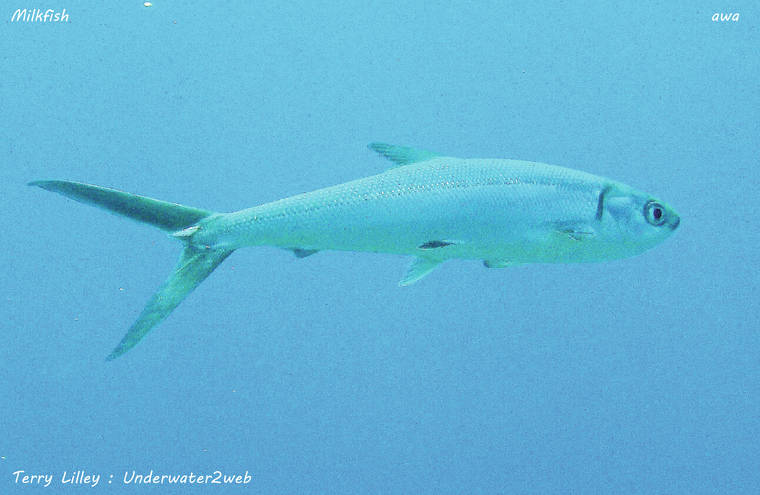This time of year, when the surf starts to get smaller on the North Shore of O‘ahu and Kaua‘i, we get a deep-water visitor. It is not a shark, but many surfers have fled the water thinking so because the milk-fish can get five feet long and has a dorsal fin that looks very much like a shark fin! Awa is the fish that I get asked about the most because they live in the open ocean most of their lives, so people do not know what they are when they see them right in the surf zone.
This time of year, when the surf starts to get smaller on the North Shore of O‘ahu and Kaua‘i, we get a deep-water visitor. It is not a shark, but many surfers have fled the water thinking so because the milk-fish can get five feet long and has a dorsal fin that looks very much like a shark fin! Awa is the fish that I get asked about the most because they live in the open ocean most of their lives, so people do not know what they are when they see them right in the surf zone.
Awa do not have teeth. They look like a silver-colored shark with a large forked tail and once a year in the spring they come close to shore right up onto the coral reefs to be cleaned by the cleaner wrasse. The little, four-inch-long wrasse removes small parasites from the milk-fish body and sometimes there will be six awa waiting in line to be cleaned by a single cleaner wrasse.
Awa lay their eggs once a year in shallow water, and when the babies hatch they swim up rivers and streams to live the first part of their lives in brackish, muddy water. After about six months they leave their coastal home and go way out to sea. These large fish are world travelers, and in Tahiti they are called “ava,” and in the Philippines “toothless bangus.” The milk-fish do not have many bones, and they are extremely good eating raw or cooked. When they are cooked in a soup, they turn the water white, looking like a bowl of milk, and that is how they got their name milk-fish.
Awa was a very important fish to the Hawaiian people for over 1,000 years, as this was the main fish they raised in fishponds. The milk-fish eat floating algae and grow quickly, and can live in a fishpond that has low oxygen levels. Coastal wetlands and estuaries are super important to awa, as that is where their babies thrive. In Hawai‘i, many of the wetlands have been destroyed to build on, and this has greatly reduced the awa population.
Awa that are hatched on one island may even populate a different island. This is due to surface slicks, which are a mixture of freshwater and saltwater that are blown by the wind from one island to the next. Recent studies of these surface slicks has shown that they are packed full of fish fry (baby fish). So if a developer destroys a wetland on Kaua‘i, that may ruin the awa population way out at Ni‘ihau. Everything is connected here in Hawai‘i, including the fish that may reproduce on one island but their babies will grow up on a different island.
You can see awa in action in the movie “The World’s Guide To Hawaiian Fish” on the underwater educational web at underwater2web.com. I have a whole new underwater marine-life series to be launched soon on the web that has some great movies I shot in other parts of the world. There is also a Hawaiian-marine-life identification link on my web and lots of amazing underwater pictures.
•••
Terry Lilley is a marine biologist living in Hanalei. He is co-founder of Reef Guardians Hawai‘i, a nonprofit on a mission to provide education and resources to protect the coral reef. To donate to Reef Guardians Hawai‘i go to www.reefguardianshawaii.org.


